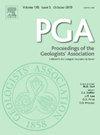A large pterosaur from the Middle Jurassic (lower Bajocian) of Rutland, United Kingdom
IF 1.2
4区 地球科学
Q2 Earth and Planetary Sciences
引用次数: 0
Abstract
An incomplete, but large hollow bone is identified as pterosaurian on account of its pneumatic nature, thin bone wall, palaeohistology and the characteristic surface texture of the peridermal bone. Despite being incomplete it is tentatively identified as a ?left ulna, and is remarkable for its size. Coming from the lower Middle Jurassic Lincolnshire Limestone Formation of Rutland, eastern England, this is the first record anywhere in the World of a Bajocian pterosaur, and probably the first pterosaur recorded from Rutland. It is most likely from Discites to Laeviuscula zones part of the lower Bajocian succession, and represents one of the largest Jurassic pterosaurs yet recorded, with a wingspan tentatively estimated at between 3.5 and 4.0 m. The taxonomic identity of the new specimen is uncertain, but it is likely allied to the Pterodactyloidea on account of its size, although presently it remains Pterosauria fam. et gen., et sp. indet.
来自英国拉特兰中侏罗世(下巴约西亚)的一种大型翼龙
由于其气动性质、薄骨壁、古组织学和表皮骨的特征表面纹理,一个不完整但大的空心骨被确定为翼龙骨。尽管它是不完整的,但它暂时被确定为左尺骨,并且它的大小非常引人注目。来自英格兰东部拉特兰郡中侏罗世林肯郡石灰岩地层,这是世界上第一个记录到的巴约西亚翼龙,也可能是拉特兰郡记录到的第一个翼龙。它很可能来自discite到Laeviuscula地带,是巴约西亚下部演替的一部分,是迄今为止有记录的最大的侏罗纪翼龙之一,翼展初步估计在3.5到4.0 米之间。新标本的分类身份尚不确定,但由于其大小,它可能属于翼手亚科,尽管目前它仍然是翼龙家族。Et gen., Et sp.;
本文章由计算机程序翻译,如有差异,请以英文原文为准。
求助全文
约1分钟内获得全文
求助全文
来源期刊
CiteScore
2.70
自引率
8.30%
发文量
54
审稿时长
6-12 weeks
期刊介绍:
The Proceedings of the Geologists'' Association is an international geoscience journal that was founded in 1859 and publishes research and review papers on all aspects of Earth Science. In particular, papers will focus on the geology of northwestern Europe and the Mediterranean, including both the onshore and offshore record. Following a long tradition, the PGA will focus on: i) a range of article types (see below) on topics of wide relevance to Earth Sciences ii) papers on aspects of Earth Science that have societal relevance including geoconservation and Earth management, iii) papers on palaeoenvironments and palaeontology of the Mesozoic and Cenozoic, iv) papers on aspects of Quaternary geology and climate change, and v) papers on the history of geology with particular reference to individuals that have shaped the subject. These topics will also steer the content of the themes of the Special Issues that are published in the PGA.

 求助内容:
求助内容: 应助结果提醒方式:
应助结果提醒方式:


